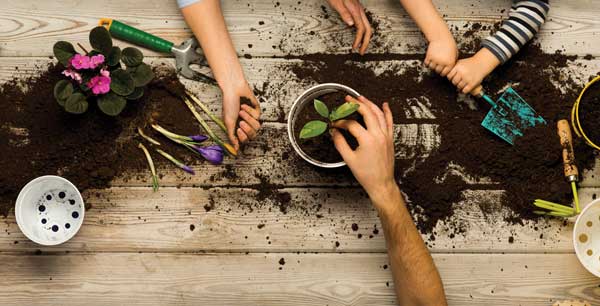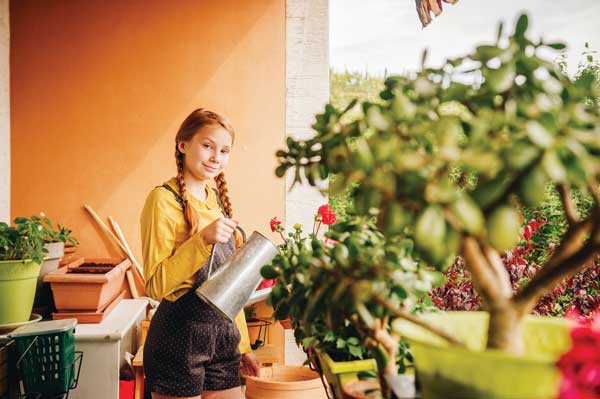It may not be as exciting as playing Fortnite, but if you’re willing to put in the time and have a little patience, gardening can be a fun and rewarding experience. It’s great for the environment, good exercise and at the end, you can eat the fruits of your labour!

Container gardening is a perfect way for you to start gardening at home—it doesn’t require a lot of space and is portable, budget-friendly and low maintenance. In other words, it’s a great way to get growing.
1. Pick your plants
Choose the types of plants you want to grow. Growing from seeds will take longer for the final product but it’s exciting to watch the entire growing cycle. The whole family will love watching the little seedlings emerge from the soil. When buying seeds be sure to follow the sowing instructions written on the packet. For beginners, herbs are a wonderful entry point into gardening—they are easy to grow, compact and a tasty addition to salads, stir-frys and homemade sauces such as pesto. You can even grow from leftover fruit and vegetable cuttings. Pick two or three plants that you like to eat to get started.
2. Select your containers
The size of the plant will determine the size of your pot, but you can pretty much grow them in any kind of container. Consider what kind of items around the house can be reused as planters. Yoghurt pots, milk cartons, plastic bottles, old cans, egg cartons and even old toy trucks can all be upcycled into planters. You can easily turn this into a fun craft project by decorating pots and containers with stickers, glitter glue or paint to give your plants an extra pretty home. Just be sure to drill or punch holes in the bottom of the container to let excess water drain out.
3. Get dirty
It’s important to use quality soil for your plants. This will anchor the roots and create a fertile environment for your plants to grow. Potting soil is typically used for container growing as it is sterilised for insects, pests and micro-organisms and treated with nutrients to give your plants a boost. Potting soil is available in 20kg bags from the plant souq near the Wholesale Market or the gardening section in stores such as IKEA and Carrefour.
4. Feed your garden
All plants need a certain amount of sunlight and water, so do your research to make sure they are getting everything they need to thrive. Find a sunny spot on the balcony or by a kitchen window, and keep in mind that some plants such as tomatoes need a lot of sunlight. For watering, be consistent. Don’t overwater and saturate the soil. A good rule of thumb is to test the soil—just dip your finger in the top few centimetres of the soil—if it’s dry, then it’s time to water!
Container gardening is an easy and convenient way to start growing on your own at home. It is also a fun and interactive way for the whole family to enjoy time together. And as an added bonus you’ll have lots of delicious (and organic!) homegrown produce at hand.
Questions to ask along the way
Growing plants isn’t just a fun hobby. It’s also a great way to practice your investigation and problem-solving skills. Alex Burke, a second-grade teacher at the American School of Doha, helped us come up with a few questions to ask as you tend your garden:
Growing plants isn’t just a fun hobby. It’s also a great way to practice your investigation and problem-solving skills. Alex Burke, a second-grade teacher at the American School of Doha, helped us come up with a few questions to ask as you tend your garden:

- Why did one plant grow faster than the other?
- Can you give a plant too much water? Too much sun?
- Which plants seem to attract bugs and which ones don’t?
- How do your homegrown vegetables taste compared to store bought? How do they look?
- What jobs do you think the petals and roots do?
- How would you grow without soil?



